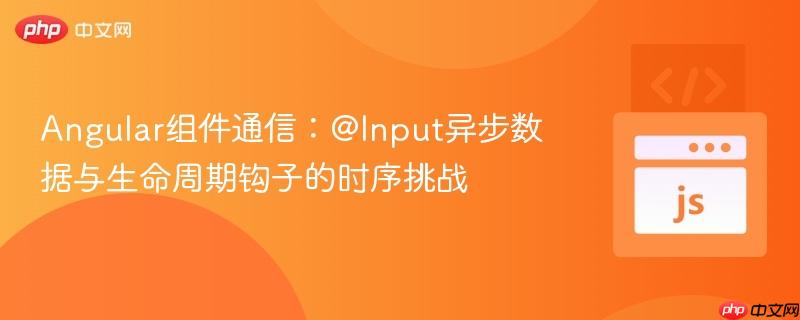
在angular应用中,父子组件之间最常见的通信方式之一是通过@input装饰器将数据从父组件传递给子组件。子组件通常会在其ngoninit生命周期钩子中执行初始化逻辑,包括访问这些输入属性。然而,当父组件传递的数据是异步获取时,例如来自api请求、定时器或用户交互,子组件的ngoninit可能会在数据实际到达之前执行。
例如,一个父组件可能将一个FormGroup实例传递给子组件:
父组件模板 (parent.component.html)
<app-custom-dropzone [field]="'qImage'" [formData]="questionForm"></app-custom-dropzone>
父组件逻辑 (parent.component.ts)
import { Component, OnInit } from '@angular/core';
import { FormBuilder, FormGroup, FormControl } from '@angular/forms';
@Component({
selector: 'app-parent',
template: `
`
})
export class ParentComponent implements OnInit {
questionForm: FormGroup;
constructor(private fb: FormBuilder) { }
ngOnInit(): void {
this.questionForm = this.fb.group({
qText: ['Initial Text'],
qImage: [''] // 初始化 qImage
});
// 模拟异步数据加载,例如从后端获取图片URL
setTimeout(() => {
this.questionForm.get('qImage')?.patchValue('https://example.com/async_image.jpg');
console.log('Parent: qImage 异步赋值完成。');
}, 1000); // 1秒后赋值
}
patchAsyncValue(): void {
this.questionForm.get('qImage')?.patchValue('https://example.com/new_async_image.png');
}
}在上述例子中,qImage的值在ngOnInit后通过setTimeout异步设置。
子组件逻辑 (custom-dropzone.component.ts)
import { Component, Input, OnInit } from '@angular/core';
import { FormGroup } from '@angular/forms';
@Component({
selector: 'app-custom-dropzone',
template: `
<div [formGroup]="formData">
<input type="text" [formControlName]="field">
<p>当前 {{field}} 值 (通过 getter): {{ currentFieldValue }}</p>
</div>
`
})
export class CustomDropzoneComponent implements OnInit {
@Input() field: string;
@Input() formData: FormGroup;
currentFieldValue: string = '';
constructor() { }
ngOnInit(): void {
console.log('Child (ngOnInit): formData 对象', this.formData);
console.log('Child (ngOnInit): formData.value', this.formData?.value);
if (this.field && this.formData && this.formData.get(this.field)) {
this.currentFieldValue = this.formData.get(this.field)?.value;
console.log(`Child (ngOnInit): ${this.field} 的值`, this.currentFieldValue);
} else {
console.log(`Child (ngOnInit): 无法获取 ${this.field} 的值,可能还未初始化或不存在。`);
}
}
}在这种情况下,当子组件的ngOnInit执行时,this.formData可能已经是一个FormGroup实例,但其内部的qImage控件可能尚未接收到父组件异步设置的值。因此,this.formData.value或this.formData.get(this.field)?.value在此时会显示为空或其初始值。
另一个常见误解源于浏览器控制台对对象日志的显示方式。当你执行 console.log(this.formData) 时,控制台通常会记录一个对该对象的引用。当你点击并展开控制台中的这个对象时,浏览器会去查询该对象当前的状态并显示出来。
这意味着,如果在ngOnInit中日志记录了this.formData,即使当时qImage的值是空的,但如果父组件在ngOnInit之后(例如1秒后)异步更新了qImage的值,当你展开控制台中的this.formData对象时,你看到的是更新后的、带有qImage值的状态。这会给人一种错觉,认为ngOnInit时qImage就已经有值了,但实际上并非如此。
相反,console.log(this.formData.value)会立即记录formData对象在日志执行那一刻的value属性的快照。如果当时qImage的值确实为空,那么日志就会显示为空。
为了确保子组件能够正确、及时地获取并响应父组件传入的异步数据,可以采用以下几种方法:
ngOnChanges钩子会在组件的任何数据绑定输入属性(即带有@Input装饰器的属性)发生变化时被调用。它在ngOnInit之前执行,并且在后续的每次输入属性变化时都会执行。
import { Component, Input, OnInit, OnChanges, SimpleChanges } from '@angular/core';
import { FormGroup } from '@angular/forms';
@Component({
selector: 'app-custom-dropzone',
template: `
<div [formGroup]="formData">
<input type="text" [formControlName]="field">
<p>当前 {{field}} 值 (通过 ngOnChanges): {{ currentFieldValue }}</p>
</div>
`
})
export class CustomDropzoneComponent implements OnInit, OnChanges {
@Input() field: string;
@Input() formData: FormGroup;
currentFieldValue: string = '';
constructor() { }
ngOnInit(): void {
console.log('Child (ngOnInit): 执行');
}
ngOnChanges(changes: SimpleChanges): void {
// 检查 formData 是否发生变化且有值
if (changes['formData'] && changes['formData'].currentValue) {
console.log('Child (ngOnChanges): formData 发生变化。', changes['formData'].currentValue);
// 确保 field 和 formData 及其对应的 control 存在
if (this.field && this.formData && this.formData.get(this.field)) {
this.currentFieldValue = this.formData.get(this.field)?.value;
console.log(`Child (ngOnChanges): ${this.field} 的值`, this.currentFieldValue);
}
}
}
}通过ngOnChanges,你可以在formData输入属性首次设置或后续更新时捕获到最新的值。
为@Input属性定义一个setter方法,可以在每次该属性接收到新值时执行自定义逻辑。这提供了一种即时响应输入属性变化的机制。
import { Component, Input, OnInit } from '@angular/core';
import { FormGroup } from '@angular/forms';
@Component({
selector: 'app-custom-dropzone',
template: `
<div [formGroup]="internalFormData">
<input type="text" [formControlName]="field">
<p>当前 {{field}} 值 (通过 Setter): {{ currentFieldValue }}</p>
</div>
`
})
export class CustomDropzoneComponent implements OnInit {
@Input() field: string;
currentFieldValue: string = '';
internalFormData: FormGroup; // 使用一个内部变量来存储 formData
@Input()
set formData(value: FormGroup) {
if (value) {
this.internalFormData = value;
console.log('Child (Setter): formData 收到新值。', this.internalFormData);
// 在这里访问值,确保控件存在
if (this.field && this.internalFormData.get(this.field)) {
this.currentFieldValue = this.internalFormData.get(this.field)?.value;
console.log(`Child (Setter): ${this.field} 的值`, this.currentFieldValue);
}
}
}
get formData(): FormGroup {
return this.internalFormData;
}
constructor() { }
ngOnInit(): void {
console.log('Child (ngOnInit): 执行');
// 注意:ngOnInit 时,setter 可能已经执行过一次
// 如果 formData 在 ngOnInit 前就已可用,这里的 internalFormData 会有值
// 如果是异步,setter 会在数据到达时触发
}
}使用setter的优点是它对特定输入属性的变化反应更精确,不会像ngOnChanges那样对所有输入属性的变化都触发。
通常,你可以在ngOnInit中执行那些只需要在组件初始化时执行一次的逻辑,而将依赖于@Input数据且可能需要多次执行的逻辑放在ngOnChanges或@Input的setter中。
如果FormGroup中的特定控件的值是异步更新的,你可能还需要在子组件中订阅该控件的valueChanges事件来响应其内部值的变化:
import { Component, Input, OnInit, OnDestroy } from '@angular/core';
import { FormGroup } from '@angular/forms';
import { Subscription } from 'rxjs';
@Component({
selector: 'app-custom-dropzone',
template: `
<div [formGroup]="formData">
<input type="text" [formControlName]="field">
<p>当前 {{field}} 值 (通过 valueChanges): {{ currentFieldValue }}</p>
</div>
`
})
export class CustomDropzoneComponent implements OnInit, OnDestroy {
@Input() field: string;
@Input() formData: FormGroup;
currentFieldValue: string = '';
private valueChangesSubscription: Subscription;
constructor() { }
ngOnInit(): void {
// 确保 formData 和 field 存在,并订阅控件的值变化
if (this.formData && this.field) {
const control = this.formData.get(this.field);
if (control) {
this.valueChangesSubscription = control.valueChanges.subscribe(value => {
this.currentFieldValue = value;
console.log(`Child (valueChanges): ${this.field} 的新值是`, value);
});
}
}
}
ngOnDestroy(): void {
// 清理订阅,防止内存泄漏
if (this.valueChangesSubscription) {
this.valueChangesSubscription.unsubscribe();
}
}
}这种方法尤其适用于FormGroup或FormControl内部的值会动态变化,并且子组件需要实时响应这些变化的情况。
在Angular中处理@Input传入的异步数据时,理解生命周期钩子的执行顺序和浏览器控制台的日志行为至关重要。ngOnInit在组件初始化时执行,但可能早于异步数据的实际到达。console.log(object)记录的是对象引用,其显示的内容可能在日志记录后更新。
为了确保正确处理异步数据,推荐使用ngOnChanges来响应输入属性的整体变化,或使用@Input的setter来精确控制特定输入属性的变化逻辑。对于FormGroup内部控件值的异步更新,订阅FormControl的valueChanges事件是获取最新值的可靠方式。通过这些方法,可以构建出更健壮、更可预测的Angular组件。
以上就是Angular组件通信:@Input异步数据与生命周期钩子的时序挑战的详细内容,更多请关注php中文网其它相关文章!

每个人都需要一台速度更快、更稳定的 PC。随着时间的推移,垃圾文件、旧注册表数据和不必要的后台进程会占用资源并降低性能。幸运的是,许多工具可以让 Windows 保持平稳运行。

Copyright 2014-2025 https://www.php.cn/ All Rights Reserved | php.cn | 湘ICP备2023035733号